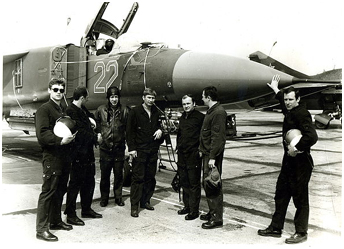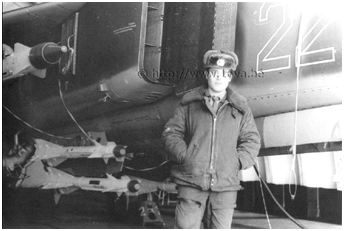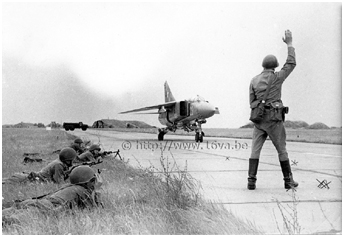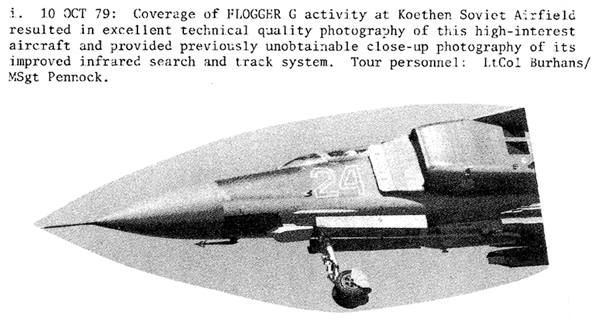
 Bill Burhans served as a tour officer with the USMLM Air Team from July 1971 to June 1975. He returned in 1979 to command Detachment 16,
7113th Special Activities Squadron (the Air Team), departing in early spring 1980 following a December 1979 Soviet-originated nasty incident.
He recalls for us a targeted tour to Köthen airfield that gave excellent results.
Bill Burhans served as a tour officer with the USMLM Air Team from July 1971 to June 1975. He returned in 1979 to command Detachment 16,
7113th Special Activities Squadron (the Air Team), departing in early spring 1980 following a December 1979 Soviet-originated nasty incident.
He recalls for us a targeted tour to Köthen airfield that gave excellent results.
The Defense Intelligence Agency (DIA) employed a prioritized collection tasking system. It included Specific Intelligence Collection Requirements, which were defined as "An identified gap in intelligence holdings that may be satisfied only by collection action, and that has been validated by the appropriate requirements control authority. Also known as SICR." (US Department of Defense Dictionary of Military and Associated Words). Assignments were very specific and allowed collectors to focus their assets on priority items. During the intervening four years since my departure from the Air Team in 1975, I was promoted to lieutenant colonel and gained more experience at higher levels within the intelligence community. I now was more knowledgeable about what was being collected where, with what level of success and by whom. I was able to evaluate what the Air Team was doing circa 1979 and came to several conclusions. My main concerns were what I perceived as a lack of focus and a duplication of efforts. In the four years since I had left the unit, the primary and alternate targeting program we had used so effectively in the early 1970s essentially had been abandoned. Instead, individual reconnaissance tour officers seemingly had adopted directionless "make it up as you go along" reconnaissance touring.

Satellite and other sensitive collection programs were providing excellent coverage of the aircraft strength of the regiments assigned to the Soviet 16th Air Army and East German Air Force operating in the restricted air space over East Germany. There really was no need for an Air Team reconnaissance tour to cover a flying program at an airfield where the number and type of aircraft already were well known. At the same time, there was a pressing requirement to observe and record specific weapons loads, the number of fuselage- and wing-mounted weapons stations on specific aircraft models and weapons delivery tactics at bomb and gunnery ranges. There also were requirements for close-up technical photography of high-interest weapon systems and installed components to permit identification and categorization.
 The Air Team was a unique asset in the US intelligence community. There was no reason to waste this asset on collection of information already being gathered successfully elsewhere.
We needed to concentrate on collection of information solely, or predominantly, accessible to a human source on the ground as stipulated in the SICR.
I introduced what I liked to call "targeted tours." By this I meant assignment of one high-priority target to the reconnaissance tour team for their two-day trip, with alternate tasking
should the team either be successful with the primary target or, for whatever reason, be unable to accomplish the primary mission. The analysts in the Targets Section of Air Team Operations
thoroughly briefed each reconnaissance tour officer and tour NCO on all SICR pertaining to each target in the target brief.
I decided to set an example for my Air Team troops by demonstrating I knew what their job entailed and understood what it took to obtain the desired results. I examined extant high-priority
requirements and selected one I believed could be met if the mission was planned properly, the weather cooperated and the situation in the field unfolded accordingly.
The MiG-23ML FLOGGER G was the target I chose. The latest version to date of this MiG-23 swing-wing fighter-interceptor was equipped with an improved infrared search and track system (IRSTS)
(1) of very high interest to USAF analysts at the Foreign Technology Division, Air Force Systems Command. Analysts there needed close-up
technical-quality photography of the IRTS sensor mounted on the aircraft fuselage under the nose in front of the nose wheel. Good coverage would allow determination of the frequency used and
other specifications. What needed to be done was very clear, as was the location where we had to be to get the requisite pictures - Köthen Soviet Airfield, where new FLOGGER G aircraft
recently had been assigned to the 73rd Guards Fighter Aviation Regiment based there.
The Air Team was a unique asset in the US intelligence community. There was no reason to waste this asset on collection of information already being gathered successfully elsewhere.
We needed to concentrate on collection of information solely, or predominantly, accessible to a human source on the ground as stipulated in the SICR.
I introduced what I liked to call "targeted tours." By this I meant assignment of one high-priority target to the reconnaissance tour team for their two-day trip, with alternate tasking
should the team either be successful with the primary target or, for whatever reason, be unable to accomplish the primary mission. The analysts in the Targets Section of Air Team Operations
thoroughly briefed each reconnaissance tour officer and tour NCO on all SICR pertaining to each target in the target brief.
I decided to set an example for my Air Team troops by demonstrating I knew what their job entailed and understood what it took to obtain the desired results. I examined extant high-priority
requirements and selected one I believed could be met if the mission was planned properly, the weather cooperated and the situation in the field unfolded accordingly.
The MiG-23ML FLOGGER G was the target I chose. The latest version to date of this MiG-23 swing-wing fighter-interceptor was equipped with an improved infrared search and track system (IRSTS)
(1) of very high interest to USAF analysts at the Foreign Technology Division, Air Force Systems Command. Analysts there needed close-up
technical-quality photography of the IRTS sensor mounted on the aircraft fuselage under the nose in front of the nose wheel. Good coverage would allow determination of the frequency used and
other specifications. What needed to be done was very clear, as was the location where we had to be to get the requisite pictures - Köthen Soviet Airfield, where new FLOGGER G aircraft
recently had been assigned to the 73rd Guards Fighter Aviation Regiment based there.
 One individual who was on the Air Team when I departed in 1975 was still there in 1979 - Master Sergeant Mert Pennock, an excellent and experienced reconnaissance tour NCO. He and I had traveled
together on many occasions in the past and strong mutual trust existed between us. We pored over the collection requirements for the IRST sensor to identify exactly what was needed. We carefully
studied the 1:25,000-scale target map for Köthen Soviet Airfield to determine precisely where we had to be to get the required coverage. This airfield was located about 10 miles west of the highway
bridge over the Berlin-Dresden Autobahn at Thurland. I knew from my previous tour of duty that this was a difficult target to reach undetected.
After departing the Potsdam House very early in the morning on October 10, 1979, Mert and I spent a long time using circuitous routing to make our way undetected about 65 miles south from Potsdam
to a stand-off (preliminary) observation point (OP). We were slightly north of the village of Görzig and on the highest point in a field. A lot of farming went on in this area south of the airfield;
there were numerous fields of corn from which to choose for this pre-OP. The corn was tall enough to completely hide the Ford Bronco in which we were traveling so we would be virtually invisible.
We had a 360° field of vision that allowed us to monitor the area for nark activity. We had gotten into this spot before first light and were reasonably sure no one knew our precise position, or,
for that matter, that we even were in the area. We settled in to wait for flying activity. Since the wind was from the west, we were confident we could find the optimum position from which to
cover the activity we hoped would eventually take place.
Despite quite good weather, there was no discernible activity for quite a long time. Although we were fairly close to the airfield, we did not hear any engine noise or detect any other activity.
Then we heard the sound of what probably was a takeoff. Apparently a flying program was beginning. All of a sudden, out of nowhere appeared a FLOGGER G, which turned above us in a short tactical
final approach to the airfield for landing. The time had come to move in closer to the target.
One individual who was on the Air Team when I departed in 1975 was still there in 1979 - Master Sergeant Mert Pennock, an excellent and experienced reconnaissance tour NCO. He and I had traveled
together on many occasions in the past and strong mutual trust existed between us. We pored over the collection requirements for the IRST sensor to identify exactly what was needed. We carefully
studied the 1:25,000-scale target map for Köthen Soviet Airfield to determine precisely where we had to be to get the required coverage. This airfield was located about 10 miles west of the highway
bridge over the Berlin-Dresden Autobahn at Thurland. I knew from my previous tour of duty that this was a difficult target to reach undetected.
After departing the Potsdam House very early in the morning on October 10, 1979, Mert and I spent a long time using circuitous routing to make our way undetected about 65 miles south from Potsdam
to a stand-off (preliminary) observation point (OP). We were slightly north of the village of Görzig and on the highest point in a field. A lot of farming went on in this area south of the airfield;
there were numerous fields of corn from which to choose for this pre-OP. The corn was tall enough to completely hide the Ford Bronco in which we were traveling so we would be virtually invisible.
We had a 360° field of vision that allowed us to monitor the area for nark activity. We had gotten into this spot before first light and were reasonably sure no one knew our precise position, or,
for that matter, that we even were in the area. We settled in to wait for flying activity. Since the wind was from the west, we were confident we could find the optimum position from which to
cover the activity we hoped would eventually take place.
Despite quite good weather, there was no discernible activity for quite a long time. Although we were fairly close to the airfield, we did not hear any engine noise or detect any other activity.
Then we heard the sound of what probably was a takeoff. Apparently a flying program was beginning. All of a sudden, out of nowhere appeared a FLOGGER G, which turned above us in a short tactical
final approach to the airfield for landing. The time had come to move in closer to the target.

Köthen Airfield was in the Dessau Permanently Restricted Area (PRA) that extended east and west several kilometers from the ends of the runway (see the airplane symbol in the middle of the map). However, this PRA was relatively narrow north to south, meaning we could drive right up to the perimeter fence at the east end of the runway if we so desired and be about three mile inside the restricted area. As we proceeded northeast towards Arensdorf to get closer to the activity, Mert and I assessed our situation. Although we were in the PRA, our timing was apparently perfect. The closer we came to Arensdorf, the more obvious it became: nobody was around and no one even knew we were in the area. There was no traffic on Route 183, which ran between the cities of Zörbig and Köthen. The fields were firm, giving us plenty of room to run. Although we were inside the PRA, we had numerous avenues of escape should the need arise. If confronted in our OP during an attempted detention, all we needed to be able to do was to make it to Route 183, then speed south to exit the PRA. We rapidly proceeded into the small village of Arensdorf and proceeded north of town into an apple orchard (now a cultivated field). We were directly in the line of flight underneath the approaching aircraft, exactly where we needed to be. An aircraft on final approach would soon be passing low over our heads. Mert stopped the Bronco and I jumped out holding my Nikon F camera with 1000mm Nikor lens. I took several shots of this bird. We were a mile-and-a-half from the runway threshold.

 A couple of minutes later, another aircraft appeared headed our way. Since at this point we were just slightly east of the inner marker beacon (about a half-mile away) over which landing aircraft
passed at an altitude of approximately 100 meters (325 feet), this aircraft would be close to that altitude by the time it flew over us. Using the same long lens, the IRST sensor almost filled
the frame. The trick now was to ensure the lens was focused correctly and the image of the sensor was crystal clear.
Since there was absolutely no one around, we decided to move in even closer to the end of the runway. We moved as far as we could westwards toward the end of the runway until we reached the
railroad embankment. The tracks ran north and south just east of and parallel with the airfield perimeter fence; the embankment shielded us from view from the airfield. We could not go any
closer, but we actually did not need to do so. The aircraft were passing very low over us at this point just prior to touching down on the runway. We were so close that I had the feeling I could
have tossed a stone and hit the concrete runway!
The next aircraft was low as it roared in to land. By this time I was alternating between lenses, using the 180mm and the 500mm lenses. It would be very hard to mess up now, as the 180mm lens
was an outstanding piece of equipment and very easy to focus. I concentrated on positioning myself directly underneath the aircraft so as to photograph the IRST sensor straight on. Looking
back on all this now, I wish I had laid down on my back so I would have an even better result, but...
We took a half-dozen more aircraft, then packed up and left, very confident we had the coverage we needed. To this day I am convinced no one knew where we were or what we had accomplished!
The resulting photography was awesome! One close-up photo provided a full-frame head-on view of the IRST sensor. Analysts were able to count the individual facets on the three faces of the device.
We received an outstanding evaluation from the Defense Intelligence Agency and the Foreign Technology Division, Air Force Systems Command for this coverage.
Unfortunately, that particular photo was not selected for inclusion in the declassified official 1979 USMLM history. Instead, what is shown below is another in that series, and the only picture
of the IRST sensor available to me right now, this being a scan from a scanned Xerox copy of that history.
But, it certainly is possible that the other side somehow did find out about that successful mission. It is even feasible that this collection effort became the straw that broke the camel's back
and resulted in the decision by the Soviets to mount an operation to get rid of me, which unfortunately was successful two months later. I like to think that the Soviet side feared my collection
skills so much that they saw to it I was fired from my command position and reassigned out of USMLM...
A couple of minutes later, another aircraft appeared headed our way. Since at this point we were just slightly east of the inner marker beacon (about a half-mile away) over which landing aircraft
passed at an altitude of approximately 100 meters (325 feet), this aircraft would be close to that altitude by the time it flew over us. Using the same long lens, the IRST sensor almost filled
the frame. The trick now was to ensure the lens was focused correctly and the image of the sensor was crystal clear.
Since there was absolutely no one around, we decided to move in even closer to the end of the runway. We moved as far as we could westwards toward the end of the runway until we reached the
railroad embankment. The tracks ran north and south just east of and parallel with the airfield perimeter fence; the embankment shielded us from view from the airfield. We could not go any
closer, but we actually did not need to do so. The aircraft were passing very low over us at this point just prior to touching down on the runway. We were so close that I had the feeling I could
have tossed a stone and hit the concrete runway!
The next aircraft was low as it roared in to land. By this time I was alternating between lenses, using the 180mm and the 500mm lenses. It would be very hard to mess up now, as the 180mm lens
was an outstanding piece of equipment and very easy to focus. I concentrated on positioning myself directly underneath the aircraft so as to photograph the IRST sensor straight on. Looking
back on all this now, I wish I had laid down on my back so I would have an even better result, but...
We took a half-dozen more aircraft, then packed up and left, very confident we had the coverage we needed. To this day I am convinced no one knew where we were or what we had accomplished!
The resulting photography was awesome! One close-up photo provided a full-frame head-on view of the IRST sensor. Analysts were able to count the individual facets on the three faces of the device.
We received an outstanding evaluation from the Defense Intelligence Agency and the Foreign Technology Division, Air Force Systems Command for this coverage.
Unfortunately, that particular photo was not selected for inclusion in the declassified official 1979 USMLM history. Instead, what is shown below is another in that series, and the only picture
of the IRST sensor available to me right now, this being a scan from a scanned Xerox copy of that history.
But, it certainly is possible that the other side somehow did find out about that successful mission. It is even feasible that this collection effort became the straw that broke the camel's back
and resulted in the decision by the Soviets to mount an operation to get rid of me, which unfortunately was successful two months later. I like to think that the Soviet side feared my collection
skills so much that they saw to it I was fired from my command position and reassigned out of USMLM...
In order to know the circumstances of this eviction read the following > Link.

notes
(1) The MiG-23ML IR sensor designated TP-23M was an evolution of the TP-23 mounted under the nose of the MiG-23M "Flogger-B." The "Flogger-G" model had three translucent panels in the front, while the old TP-23 had only two. The TP-23M, coupled with the AVM-23 analog computer, was capable of firing R-3S (AA-2 "Atoll"), R-23T (AA-7 "Apex") and R-60 (AA-8 "Aphid") missiles.
 |
Plan du site - Sitemap |  |
